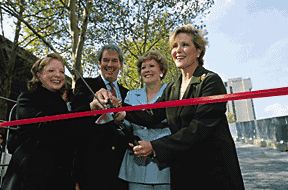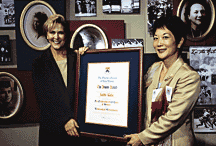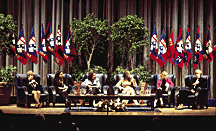“Do we have a lot to celebrate? You bet we do,” declared Penn President Judith Rodin CW’66, to the enthusiastic applause and cheers of the audience gathered under a gigantic tent that spanned Wynn Commons.
The luncheon at which she was speaking was part of the festivities marking 125 Years of Women at Penn on November 1-2. During her remarks, Rodin recalled how Judy Berkowitz CW’64, the trustee and former chair of the Trustees Council of Penn Women (TCPW) who organized the celebration, had first approached her with an idea she “just wanted to run by” her.
Immediately, Rodin said, she realized that “beyond a good idea, it would be as amazing, as wonderful, as inspiring, and as thrilling as this event has been.”
Rodin, who was presented with the TCPW’s sixth Beacon Award for furthering the advancement of women, said that by honoring her the TCPW was “really honoring Penn’s heritage of empowering women to transform our own lives and to make lasting contributions to all fields of human endeavor.”
True, it took 136 years for Penn to make the “first tentative steps” to equal educational access for women and “another 118 after that until a woman was chosen to permanently lead this University,” Rodin noted. But given the obstacles and the dearth of opportunities for educational advancement in other parts of the world, “we not only have the right to look back with pride on our accomplishments but we bear an important responsibility to ensure that every woman who wants an education has the means, the opportunity, and the resources to get one.
“I’m proud to say that with the help of so many people in this room,” she added, “Penn continues to encourage women to blaze their own trails of exploration, their own trails of discovery and problem-solving right into positions of leadership and influence in the arts and sciences and professions.”
Berkowitz noted that some 1,200 women had registered for the two-day celebration—which included a reception for Penn women authors, a dinner featuring a keynote speech by Andrea Mitchell CW’67, panel discussions, the publication of a book (Franklin’s Daughters: Profiles of Penn Women), and the dedication of the Women’s Walkway and Class of 1949 Generational Bridge at 38th and Locust.
“Women from all around the country and the world joined together to make a joyful noise—that’s my way of describing twelve-hundred women talking,” Berkowitz said. “Mothers and daughters, sisters, roommates, and friends, all have come together to reconnect and celebrate the hard work and determination that have brought women their place at the Penn table.”
In Praise of Subversive Questions
The Penn tables at the Penn Bookstore showed ample evidence of hard work and determination in the form of dozens of books and their authors, Penn alumnae. The theme of that event was “Women as Authors, Books as Legacies.”
“Women writers have borne the torch from one feminist moment to the next through the dark years,” said Rebecca Pepper Sinkler CGS’75 Hon’91, former editor of The New York Times Book Review. “Like medieval monks, they kept the books alive, to be read again when the dawn came.”
The real mission of the University, Sinkler argued, should be to encourage the asking of tough questions. “Sometimes people ask the best questions when they’re mad at something,” she pointed out.
Sinkler also paid homage to Gertrude Klein Peirce Easby and Anna Lockhart Flanigan, the two women who had “asked an impertinent question in 1876” —namely, if they could study at the all-male University.
Eventually, “women began to ask impertinent questions in droves,” she said. “Turns out, women didn’t get just a room of our own, but classrooms and carrels and labs and whole auditoriums in which to ask our impertinent questions—not the same old questions that academia had always asked, but new questions. Questions about ourselves, our literature, our bodies, our relationships, our work.”
She dismissed the calls for faculty to be “kinder and gentler to their students,” since not only is their own work likely to suffer as a result, but the “best mentoring is almost always serendipitous—and nurturing cannot be ordained by fiat.
“I wish my alma mater would be tough on women: rile them up, annoy them, put roadblocks in the way, make sure they know who the enemy is—even if it’s you,” Sinkler concluded. “And then, if the occasion should arise, you fight for them. Insist that women get respect in your classroom, get grants, get tenure—that way they will get the courage to ask the questions they need for their own sakes and not for the sakes of their changing world. And then, of course, they will have the best shot at changing the world—if only because they changed themselves first.”
“A Very Different Speech”
Everyone remembers where they were on September 11, noted Andrea Mitchell, NBC chief foreign-affairs correspondent and a trustee of the University, just as everyone past a certain age remembers where they were when President Kennedy was assassinated. In November 1963 Mitchell was a Penn freshman living in Hill Hall, then the women’s dormitory, and while her reaction to that event helped crystallize her desire to be a journalist, she said that the “most transforming issues for most undergraduates were not the war or the civil-rights movement, but curfews [and] visiting privileges in the Quad,” then the men’s dormitories.
Despite the fact that “women were not fully integrated into the University for another decade [with the abolition of the College for Women in 1975], it never occurred to me that I couldn’t graduate, enter a male-dominated profession, and rise to a level of my own choosing,” Mitchell said. Part of that self-confidence was “hubris,” she acknowledged, “but largely it was the faculty mentors, the professors who, while challenging us to be better than we were, at the same time encouraged us to think that we could conquer the world.”
Her own world travels took her to Afghanistan in 1998, where she “tried to interview some of the women who live there as ghostly prisoners, floating through a devastated landscape, enveloped in the folds of their burkhas.” Yet only 20 years earlier, she said, “this was a rich and vibrant culture.”
Mitchell also called on her colleagues in the media to exercise some restraint, a time-out from the cable-news culture of instant analysis and second-guessing. “My generation of reporters grew up in an adversarial culture, and it was healthy,” she said, but “journalists are also citizens” and “a little bit of patience is called for in these unprecedented times.”
Patience is sometimes needed at the University, too. While women make up half of all Penn undergraduate and graduate students, she noted that only 527 of the standing faculty of 2,252 are women; only 246 are tenured; and there are nine female department or division chairs out of a total of 96, which is “not nearly up to the level of inclusion that the University would like.”
Noting that “we are facing entirely new challenges” in the wake of September 11, Mitchell asked: “Why do I think we can survive this? Because we are smart, we are well-educated, and we believe in a value system that differentiates us from a terrorist who would kill [thousands of] innocent people without blinking.
“I am truly proud of the way that this University has helped our students cope,” she added. “We have proved that we are a community of scholars, that we value civil discourse, and that we will protect each other in a time of trial of the nation.”

“Meet Me at the Bridge”
“We are creating a new landmark and marking a historic milestone,” said Judy Berkowitz. “This bridge spans time and distance, and since it is a living bridge, it will even reach into the future as our sons, daughters, and grandchildren join the Penn family.”
Moments later, Berkowitz, Rodin, trustee chair James Riepe W’65 WG’67, and Lynne L. Tarnopol CW’60 (fundraising chair for the 125th Celebration) had cut the ribbon dedicating the Women’s Walkway and Class of 1949 Generational Bridge. The project involved renovations to the existing bridge across Locust Walk at 38th and the addition of stone pavers commemorating donors’ connection with the University.
Berkowitz singled out Tarnopol —“fundraiser extraordinaire, a woman whom nobody says no to”—for her efforts, but most of all thanked those “whose lasting affection for your University is permanently inscribed here. When we return for Homecoming Weekend, for reunions, for athletic events, or for parents weekend, this bridge to our past and hope for the future will be where we renew our ties to our great University. As long as there is a Penn, there will be time for us all to meet at the bridge.”
The bridge “joins Penn’s past to its future by linking the historic heart of campus to the new impending bustle of Hamilton Village,” added Rodin, as well as serving as a “gateway connecting the Penn community to our West Philadelphia community.”
A Bridge of “Personal Responsibility”
A panel discussion led by Dr. Claire Fagin Hon’94, former dean of the School of Nursing and former interim president of the University, highlighted the contributions of women in the realm of health care and examined areas where more progress is needed.
According to Dr. Barbara L. Weber—professor of medicine and genetics, director of the Breast Cancer Program, and director of the Cancer Genomics Program at the Abramson Family Cancer Research Institute of Penn’s Cancer Center—one of the most important recent breakthroughs has been the discovery of two genes linked to an increased risk of breast cancer. The challenge, she said, “is how to get more people used to thinking about their individual risk of breast cancer so we can expand what we do from the relatively small group of women taking advantage of this so far.”
Dr. Ruth Katz CW’73, L’77, associate dean for administration at Yale University School of Medicine, added that women advocates have been a powerful influence in Washington, pushing for changes such as Medicare coverage for mammography. But as Dr. Marie Savard Nu’72 M’76 observed, legislation alone won’t solve every health-care problem, since there is a “large chasm between the health care we could provide with the technology that we have available and the health care that we do provide.”
Women, who consume two-thirds of the health-care dollars and make 80 percent of all health-care decisions, could play a big role in bridging that gap, Savard believes. “The bridge is made up of personal responsibility”—which includes doing research on the Internet, enrolling in clinical trials, gathering medical records so they’re “the center-point of their health information,” and forming a more collaborative relationship with their health-care system, she said. “It’s no longer this idea of ‘doctor knows best.’”
Dr. Sheila Moriber Katz WG’90, president and CEO of NewMedicine, a company dedicated to the transformation of medicine through scientific innovation, envisioned a future in which human-genome research helps scientists tailor-make drugs for specific illnesses; robotic surgery allows surgeons to take clots out of blood vessels by remote-control micro-navigation techniques; and researchers use stem cells to “grow” new human tissues and organs for transplantation.
How will such high-tech advances impact women? For one thing, they will cure some chronic illnesses and turn some acute illnesses into chronic ones. Noting that “women are traditionally caregivers” and that they “suffer disproportionately from chronic illnesses,” Katz added, “Every one of us in this room needs to keep an eye out on the research agenda of new medicine … to ensure that it is focused appropriately to meet the needs of women.”
Dr. Susan Taylor C’79, director of the Skin of Color Center at St. Luke’s Roosevelt Hospital Center and assistant clinical professor of dermatology at Columbia University, noted that “Healing is not just a scientific process,” and emphasized the importance of the patient-physician relationship.
“I think as we educate our young physicians, we need to educate them not only about the science of medicine, but also about the art of medicine,” she said, “and I think women get the art of medicine a little bit easier than many men.”
Now that women comprise 50 percent of the medical-school student population, the panelists agreed that getting women into medical school is no longer the challenge. But there is still a deficit of women in the upper ranks of academe.

“It’s actually not because the opportunity doesn’t exist. It’s that they leave academia before they get to that point,” says Weber. While a lot of that has to do with the challenges of balancing a family and an academic career, she noted, “some of it has to do with the fact that women tend to have less confidence they can actually do those things. One thing we can really do is improve on the mentoring that women provide to women who become residents and fellows and junior faculty members.

“We can also encourage women to be vocal about what their priorities are,” she added. “I have never been shy about saying, ‘I don’t come to work until my kids get off to school in the morning.’” As a result, she has noticed, “Men now start doing the same thing, saying, ‘Oh, I really should go to this Halloween parade. I think I’ll leave now.’”
Women and Giving
Women control 51 percent of the wealth in the United States, noted moderator Carol Einiger CW’70 at the outset of the panel discussion on women in philanthropy. And they are exercising the power that comes with that wealth in a variety of ways.
Evelyn Lauder, founder and chair of the Breast Cancer Research Foundation, cited the model of AIDS activists “who wouldn’t take no for an answer” as one inspiration for her approach to her chosen cause. Lauder has raised awareness and tens of millions of dollars for Memorial Sloan Kettering and then through her own foundation, which currently funds 50 researchers across the country.
Ndidi Oknonwo Nwuneli W’95 is executive director of the FATE Foundation, an organization to spur entrepreneurship by Nigerian youth, and co-founder of the Business Women’s Network for Nigerian women. Working with 300 volunteers in the private sector, she said, FATE seeks to “empower youth in general and create opportunities for women to empower themselves.”
For Laurene Powell Jobs C/W’85, funding cuts for California’s public schools in the wake of Proposition 13—which reduced the number of guidance counselors to one per 2,000 students—was the catalyst for College Track, a non-profit college-preparatory program based in East Palo Alto, which she founded five years ago and of which she is now board president. In an area where only 40 percent of high- school students graduate and 10 percent go on to college, College Track has a facility—open from 2 p.m. until 8 p.m. each day—where students can get information and services.
Of the first 20 students to complete the program, all graduated and went on to four-year colleges, half in the University of California system. “And there are 120 behind them,” she added.
Anne d’Harnoncourt Hon’88, director and CEO of the Philadelphia Museum of Art, said that women have long taken a leading role in the art field—think of Catherine the Great—and now account for about half of the directors and CEOs of arts organizations appointed over the last 20 years. She contrasted women’s leadership style to men’s, saying that women are less afraid to ask for advice and of not knowing an answer, and are more likely to pick up the phone to call anybody. “Diplomacy versus raw power is something that interests women,” she said.
Judith Vredenburgh CW’70, president and CEO of Big Brothers/Big Sisters of America, said that she had previously run a for-profit company and “non-profit is harder.” She stressed the importance of business-style metrics to determine—and demonstrate to donors—how effective non-profits are in their work. “We need to force ourselves to measure quality,” she said, “and we can measure quantity.”
The “Enormous Power” of the Media
“Those first generations of women, who are no longer with us in physical presence but who are with us psychologically, had a kind of courage that made possible the kind of advancement that we’ve seen in the society at large but also at this institution,” noted Dr. Kathleen Hall Jamieson, dean of the Annenberg School for Communication and director of the Annenberg Public Policy Center. Jamieson, who headed a “Media and Politics” seminar titled: “The Second Sex: What a Difference the Difference Makes,” noted that “the fact that we have a female president at this university is a direct by-product of that tradition.”
Photographer Mary Ellen Mark FA’62 ASC’64 Hon’94, whom Jamieson hailed as “the most distinguished photographer in the United States,” recalled that when she was starting out, “there was a long tradition of great female photographers, like Margaret Bourke-White and Dorothea Lange and Julia Margaret Cameron”—though there weren’t many women working in the magazine industry. “You were still considered somewhat of an oddity,” she said: “a girl photographer.”
But in certain areas, such as documentary photography, “it’s a great advantage being a woman,” she noted, “because I can walk down the street and knock on the door, and another woman will let me into her house, because people aren’t as threatened by women.”
Other professions are not so hospitable. Of the 25 “top media conglomerates,” none is headed by a woman, noted Susan Ness WG’83, former commissioner of the Federal Communications Commission. She also quoted from a recent study by the Annenberg Public Policy Center that found that women held just 13 percent of the executive positions and only three percent of the “clout positions”—executive vice president and above —in media companies, as well as nine percent of the board-of-director slots.
Furthermore, she added, while “media is so important and so visible, and this is where so many of our images are created and lessons learned” —other recent studies confirm that “the same level of frustration that we had experienced in communications was being experienced” in other fields.
Now, she said, there’s an “effort to examine each of these fields” and come up with recommendations to “improve the numbers of women in top leadership positions across the board.”
“Some of the most talented people I know in our industry are women,” said Mindy Herman W’82, president and CEO of E! Entertainment Television Networks. “Too often they end up in the shadows—they end up not getting their due.” While she acknowledged that she was “very fortunate” to have reached the top of her own company, she added: “It saddens me somewhat that we haven’t done better for the women that are coming up.”
In the realm of on-air talent, though, the picture is “terrific” for women, said Jean Chatzky C’86, editor-at-large for Money magazine and financial editor for NBC Today. Even in such formerly male bastions as financial reporting, women such as Chatzky are on-screen.
According to Marcia Greenberger CW’67 L’70, co-president of the National Women’s Law Center, the law and the media are closely interrelated. “The media has an enormous power to set expectations, to display role models, to set the agenda about what these issues are that we discuss on the public scene, and that affect the kinds of laws and policies that we ultimately live under,” said Greenberger. And the public policy and laws that had allowed institutions to require “killer hours for both men and women,” and have required both to make “unhealthy choices and sacrifices to compete,” she argued, are areas that “we’ve got to address.”

Women and the Bottom Line
“There is nothing more scary,” said Mandee Heller C’94 W’94, “than walking into your boss’s office when you have $80,000 in student debt and saying, ‘I’m starting my own thing, but thank you very much—you can keep the paycheck.’” Nevertheless, that’s what Heller did when she launched the Women’s Financial Network at Siebert, a financial institution created by and for women.
Taking risks and making choices were common themes in a panel discussion about women’s roles in the business world, led by CNN anchor Willow Bay C’85. Sumaya Grisales Masis CGS’71 talked about her decision to leave her native Columbia and come to the United States “because I knew that here I would have the opportunity to go to work and go to school.” Today she’s president and chief operating officer of GE Trading Company. Aerin Lauder C’92 was proud of her choice to combine motherhood with full-time work as president of global advertising for The Estée Lauder Companies. Rebecca Matthias CW’75 started a multimillion-dollar maternity-clothing business, Mothers Work Inc., out of her own front closet. And Beverly Chell CW’64, vice chairman and general counsel of Primedia Inc., co-founded what she calls “the most successful leveraged buildup company around.”
As inspiring as their examples are, the reality is “that very few women get to the top of corporate America” and women only account for 1.2 percent of the Fortune 500 CEOs, observed Willow Bay.
According to Matthias, the difficulties of juggling a career and motherhood is one reason that “more women should start their own businesses.” Though the hours can be just as long, “they do offer an element of flexibility.”
Noting that “most CEOs are in their 50s or late 40s,” and that “women in middle management now are probably in their late 30s and early 40s,” Chell predicted that “there are going to be a lot more [women CEOs] as they get up through the management cycle.”
“I think one of the most powerful things is networking,” added Heller. “It’s having events such as [the 125th Celebration] and having people recognize that there is an old girl’s network as well as an old boy’s network—or initiating an old girl’s network —that’s going to help.”

